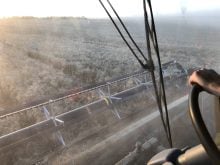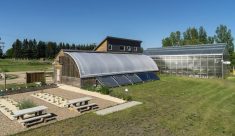Say there’s trouble with the automated GIS and mapping features on the tractor, but you can’t find a tech with enough knowledge to offer help.
It’s a simple example of the kind of employment gaps that keep farmers up at night, and that prevent their adoption of new technology, said the manager of an “upskilling” program that can potentially fill those gaps.
“About two years ago, the industry came to us to say ‘we can’t find the unique people that we need that understand technology and technology implementation but also understand agriculture and agri-food,” said Ednali Fertuck-Zehavi, manager of Palette Skills’ automation and digital agriculture specialist program.
Read Also

Seeding Indigenous agricultural prosperity
National Circle for Indigenous Agriculture and Food says Indigenous agricultural success needs strong relationships.
Why it matters: Farm equipment is increasingly technical and it takes greater technical knowledge to keep it running as needed.
Through the eight-week, 130-hour course, Palette Skills, the federally funded non-profit that has overseen the program for the past two years, hopes to train people to fill producers’ employment needs. Its latest intake occurred in August, but its website will have information on upcoming intakes.
Depending on the program for which they’re best suited, participants are trained by industry experts with hands-on, project-based learning in how emerging technologies apply to ag. Core areas include GIS (geographic information system), IoT (internet of things), drones, artificial intelligence, robotics and big data.
In the process, it seeks to develop a full suite of professional skills, including project management, fundamentals of business development, problem-solving and team building.
The program is looking for students who are unemployed or underemployed in a range of fields and who may be able to bring their skills to the agriculture table. It’s open to post-secondary graduates with a minimum of three years’ work experience.
The program’s goal is to match agri-food employers with the agriculturally and technically informed candidates they would consider hiring, said Fertuck-Zehavi.
“We see if we have someone in our talent pool and we match them.”
Palette Skills developed the program through consultation with agriculture-based academic institutions and a variety of agri-food employers.
They found that academic excitement over a new innovation didn’t necessarily line up with the needs of farmers and ranchers. Farmers may not know how to implement new ideas on their operations. This is where the fundamental idea of “filling gaps” was identified.
With the feedback from their consultation, the organization built its automation and digital agriculture specialist program.
Program details
Participants may choose from three streams based on their goals and existing work experience: agribusiness and sales; industrial, technical and professional; and data analyst and programmer.
Possible careers available to agribusiness and sales graduates include precision agronomist and crop input sales rep. This stream has attracted participants with experience in project management, human resources, marketing, business development and even law.
Those participants spend a portion of their time learning online and another portion learning the basics of farming. The ideal employee would be one who could bring new concepts and new ideas to the fray, said Fertuck-Zehavi.
“If you train them in the main expertise of the agri-food sector, they take all this transferable knowledge and they can solve problems that we have in the sector in new, exciting ways,” she said.
That can have far-reaching implications.
“Having good agri-business management talent is essential to make those operations able to compete at the international level,” she said.
For those who want to participate in the industrial, technical and professional stream, post-program options might include precision agriculture specialist, remote sensing technician or automation technician.
It’s a broad stream requiring creative and critical thinking. Students with backgrounds as varied as engineering, soil science and genetics have finished the program under this stream.
If the goal can be distilled to a single sound bite, it would be “solve problems.”
It’s a matter of identifying challenges in current systems and solving them through current or potential technologies, said Fertuck-Zehavi.
“How do we make sure that what we have right now is working in the best way? Some farmers have processing facilities that cost them $10 million, but they only use a small portion of that capacity. Ideally, the graduate would have the talent to implement it properly.”
Graduates of the data analyst and programmer stream may find jobs as ag tech software engineers, precision ag programmers and agribusiness applications developers.
This is the stream that requires the most experience in computer programming, said Fertuck-Zehavi. Some challenges relevant to agriculture will require the ability to develop software-based solutions.
“Even though they did analytics and are excited about analytics … [if they] don’t have any programming experience, they won’t be able to go to the data analyst and programmer stream,” she said.
“If you don’t have those reserve skills, you still need to go through so much growth before you’ll be able to apply for those jobs and be successful in them.”
Farmer voice
The constant input of farmers has been key to the program, which recently finished its third cohort of attendees, said Fertuck-Zehavi.
“We involve the farmer constantly in providing training, reviewing our curriculum and providing real-life problems and case studies and we’re providing data that each stream is working on — those real-life challenges that we currently have in the industry.”
Funded by the Government of Canada through Innovation, Science and Economic Development Canada, Palette Skills is a non-profit organization that develops employer-driven upskilling programs that help mid-career workers find a place in the workforce.
A version of this article first appeared in Alberta Farmer Express.
















